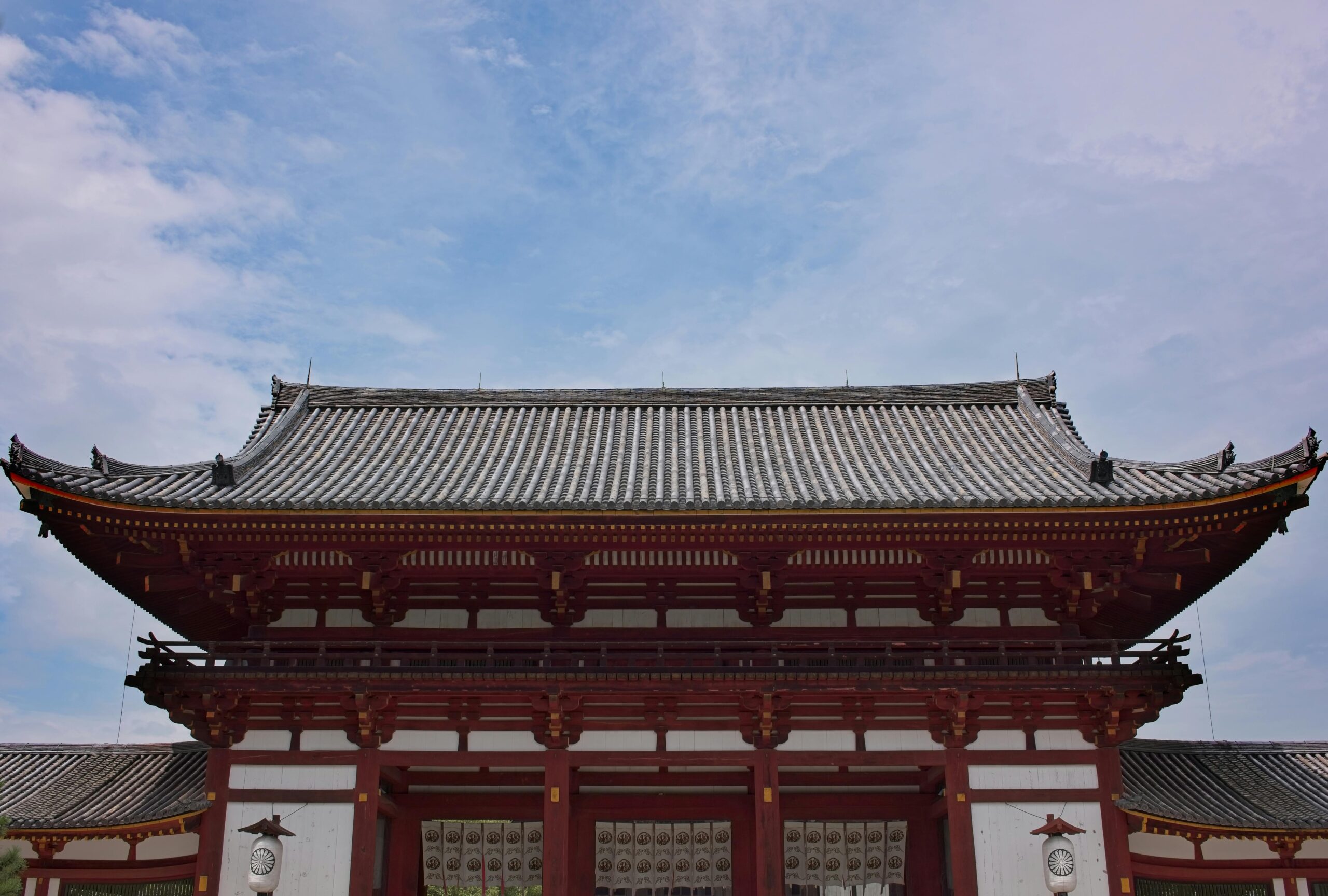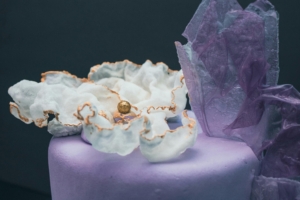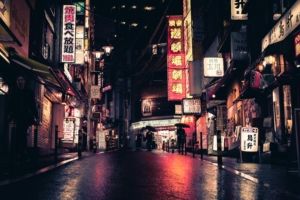Introduction to Todaiji Temple
Todaiji Temple, located in the historic city of Nara, Japan, is not only a significant cultural landmark but also a masterpiece of Japanese Buddhist architecture. Known for housing the world’s largest bronze statue of the Buddha Vairocana, the temple serves as a central point of Japanese spiritual and historical heritage.
The temple’s origins date back to the 8th century, a period rich in cultural development. Founded by Emperor Shomu, Todaiji Temple was constructed as the head temple of all provincial Buddhist temples of Japan. Its historical significance is profound, reflecting the synchronization of governmental authority and Buddhist doctrine.
- Architectural Grandeur: The Great Buddha Hall (Daibutsuden), the largest wooden structure in the world, is a testament to ancient engineering and artistic finesse.
- Spiritual Significance: The temple complex is a pivotal site for various religious ceremonies and festivities, drawing visitors and pilgrims from across the globe.
- Cultural Hub: Surrounding the temple are numerous smaller shrines and monuments, each narrating a unique story of Nara’s rich history.
Visitors to Todaiji Temple can explore various attractions within the complex, including the Nigatsu-do Hall known for its spectacular views during the Omizutori ceremony in March. The temple’s expansive grounds also offer a serene environment, ideal for reflection and relaxation.
For those planning a visit, it’s advisable to check the opening hours and entrance fees, as these can vary by season and special events. Engaging with the temple’s profound history and architectural beauty not only enriches one’s understanding of Japanese culture but also provides a memorable travel experience.
Whether you are a history enthusiast, spiritual seeker, or simply a curious traveler, Todaiji Temple offers a rich tapestry of cultural and historical significance that is bound to leave an indelible mark on your journey through Japan.
The Historical Significance of Todaiji Temple
Todaiji Temple, located in the historic city of Nara, Japan, is not only a marvel of ancient architecture but also a pivotal site in the history of Japanese Buddhism. Established in the year 752 during the Nara period, the temple has played a significant role in the cultural and religious life of Japan.
The temple is renowned for housing the Daibutsu, or the Great Buddha, one of the largest bronze statues of Buddha in the world. This statue stands as a testament to the artistic and technological achievements of the era. The construction of the Daibutsu was an ambitious project that symbolized the influence and power of Buddhism in Japan at the time.
Beyond its architectural grandeur, Todaiji Temple has been a center for Buddhist education and played a crucial role in the propagation of Buddhism throughout Japan. It served as the head temple of all provincial Buddhist temples of Japan and was a place where state-sponsored ceremonies were held.
In addition to its religious and educational importance, Todaiji Temple has been involved in several historical events that have shaped the region. It has survived many challenges over the centuries, including damage from wars and natural disasters, each time being rebuilt, symbolizing resilience and renewal.
Today, Todaiji Temple is not only a place of worship but also a symbol of peace and a popular tourist destination that attracts visitors from around the world. Its historical significance is preserved in the many artifacts and structures that can be seen when visiting the temple complex.
Visitors to Todaiji Temple can also explore the Nara Deer Park, where hundreds of free-roaming deer add to the serene and historic atmosphere of the area. The temple’s setting in Nara Park, surrounded by lush greenery and traditional gardens, further enhances its historical ambiance and provides a picturesque backdrop that is perfect for photography.
Understanding the rich history of Todaiji Temple enriches the experience of visiting this ancient site, offering insights into Japan’s cultural heritage and the enduring legacy of its religious traditions.
Architectural Marvels of Todaiji Temple
Todaiji Temple, located in the historic city of Nara, Japan, is not only a significant cultural landmark but also an architectural wonder that attracts visitors from around the globe. This temple, renowned for housing the world’s largest bronze statue of the Buddha Vairocana, showcases a unique blend of spiritual significance and architectural ingenuity.
The main hall, known as the Daibutsuden (Great Buddha Hall), is a testament to the architectural skills of ancient Japan. Reconstructed in 1709 after being destroyed by fire, it remains one of the largest wooden structures in the world. The hall’s massive wooden pillars and intricate beam work are designed to withstand the test of time and natural disasters, reflecting the ingenuity of its architects.
- The octagonal lanterns flanking the temple entrance are exquisite examples of Buddhist art and architecture, symbolizing the Infinite Light of the Buddha.
- The Nandaimon Gate, a designated National Treasure, is a brilliant example of 12th-century architecture, featuring two fierce-looking Nio guardian statues.
- The temple complex also includes additional structures such as the Bell Tower and the Lecture Hall, each contributing to the temple’s grandeur and historical value.
Visitors to Todaiji Temple are often captivated by the detailed craftsmanship evident in every corner of the temple complex. From the intricate carvings on the temple doors to the majestic roof that shelters the Great Buddha, each element is a piece of art that tells a story of devotion and meticulous skill.
Exploring Todaiji Temple offers a unique glimpse into the architectural practices of ancient Japan, combined with a spiritual experience that remains profound to this day. Whether you are a history enthusiast, an architecture aficionado, or simply seeking a peaceful retreat, Todaiji Temple promises an enriching and unforgettable experience.
Planning Your Visit to Todaiji Temple
Visiting Todaiji Temple in Nara is a journey into the heart of Japanese history and culture. This iconic temple, known for housing the world’s largest bronze statue of the Buddha Vairocana, offers more than just spiritual significance. It’s a comprehensive experience that combines architectural grandeur with serene natural landscapes.
Before you go, it’s essential to know the Todaiji Temple opening hours which are generally from 8:00 AM to 5:00 PM, but these can vary slightly depending on the season. The entrance fee is another practical aspect to consider; it is typically around 600 yen for adults, which contributes to the temple’s maintenance and preservation.
- Best time to visit Todaiji Temple: Early morning or late afternoon to avoid crowds and experience the temple in quieter, more reflective moments.
- Things to do near Todaiji Temple: Explore Nara Park, visit the Nara National Museum, or enjoy a leisurely walk through the nearby deer park.
Understanding the history of Todaiji Temple will enrich your visit. Founded in the 8th century during the Nara period, the temple was constructed under the orders of Emperor Shomu as a symbol of imperial and Buddhist authority. The Daibutsuden (Great Buddha Hall), rebuilt in the 18th century, is a testament to historical architectural techniques and artistic craftsmanship.
For those looking to enhance their experience, consider downloading a virtual tour app or picking up a detailed guidebook that offers insights into the temple’s lesser-known facts and hidden corners. Engaging with these resources can transform a simple visit into a memorable exploration of Todaiji’s spiritual and historical essence.
Lastly, integrate your visit to Todaiji Temple with other cultural sites in Nara for a fuller understanding of the region’s rich heritage. Planning a comprehensive itinerary that includes stops at other historical landmarks can provide a deeper appreciation of Japan’s cultural landscape.
Whether you’re a history enthusiast, a spiritual seeker, or a casual tourist, Todaiji Temple offers a profound glimpse into the soul of Japan, making it a must-visit destination on your travel itinerary.
Todaiji Temple Opening Hours
Planning your visit to the majestic Todaiji Temple in Nara? Knowing the opening hours is essential to ensure you make the most of your trip. Todaiji Temple, a historically significant site and a must-visit destination in Japan, welcomes thousands of visitors each year. Here’s a detailed guide to help you plan your visit.
General Opening Hours:
- Spring/Summer (April to October): 7:30 AM to 5:30 PM
- Fall/Winter (November to March): 8:00 AM to 5:00 PM
It’s important to note that these hours may vary during special events or national holidays, so checking the temple’s official website or contacting them directly before your visit is advisable.
Visiting Todaiji Temple during its opening hours allows you to experience the serene beauty of the temple grounds, explore the Great Buddha Hall (Daibutsuden), and admire the intricate details of its ancient architecture. Whether you’re interested in history, architecture, or spirituality, Todaiji Temple offers a profound glimpse into Japan’s rich cultural heritage.
For those planning a more extensive visit to Nara, consider exploring other nearby attractions such as Nara Park, Kasuga Taisha Shrine, and the Nara National Museum. Each offers unique insights and experiences, making your trip to Nara truly memorable.
Remember, the best time to visit Todaiji Temple is during the early morning or late afternoon when the crowds are smaller, and the light is perfect for photography. Enjoy your visit to this iconic symbol of Nara’s historical and cultural landscape!
Todaiji Temple Entrance Fee
Planning a visit to the historic Todaiji Temple in Nara? One of the essential details every traveler needs is the entrance fee. Todaiji Temple, known for its grandeur and cultural significance, has a modest entrance fee that helps maintain and preserve this UNESCO World Heritage site.
| Visitor Category | Entrance Fee |
|---|---|
| Adults | 600 yen |
| Students (Junior High/High School) | 400 yen |
| Children (Elementary School) | 300 yen |
The fees are utilized for the temple’s upkeep and to support ongoing preservation efforts. By paying the entrance fee, visitors contribute directly to the conservation of this important cultural asset.
Why is there an Entrance Fee?
The entrance fee to Todaiji Temple not only supports the physical maintenance of the temple but also funds the various cultural activities, educational programs, and the preservation of artifacts within the temple complex. This fee ensures that future generations will continue to enjoy and learn from this historic site.
- Supports maintenance and restoration projects
- Funds educational and cultural programs
- Helps preserve important cultural artifacts
Visiting Todaiji Temple offers more than just a glimpse into Japan’s past; it is an opportunity to actively participate in the preservation of world heritage. Remember to check the latest information before your visit as fees may vary during special exhibitions or events.
Best Time to Visit Todaiji Temple
Planning a visit to the majestic Todaiji Temple in Nara, Japan? Timing your visit can greatly enhance your experience. This guide will help you determine the best time to visit Todaiji Temple, taking into account weather, crowd sizes, and special events that could influence your trip.
Seasonal Considerations: Nara’s climate plays a significant role in planning your visit. The spring months of March to May offer cherry blossoms and comfortable temperatures, making it a popular time for both tourists and locals. However, autumn, particularly from late October to November, is equally spectacular with vibrant fall colors framing the ancient temple structures.
Crowd Sizes: To avoid large crowds, consider visiting on weekdays or during off-peak hours in the early morning or late afternoon. The temple tends to be busiest on weekends and Japanese national holidays.
Special Events: Todaiji Temple hosts several cultural and religious events throughout the year that can be a highlight of your visit. The Omizutori (Water Drawing Festival) in March and the Nara Tokae in August are particularly noteworthy. These events offer unique experiences with additional ceremonies and illuminations, but they also attract more visitors.
Understanding these factors will help you choose the ideal time for your visit, ensuring a more enjoyable and fulfilling experience at Todaiji Temple. Whether you’re seeking the serene beauty of nature or the vibrant atmosphere of a festival, Todaiji offers a memorable journey through Japan’s rich history and cultural heritage.
- Spring (March-May): Ideal for cherry blossoms and mild weather.
- Autumn (October-November): Perfect for viewing autumn leaves.
- Weekdays: Recommended for smaller crowds.
- Special Events: Check the temple’s calendar for cultural events.
By choosing the right time to visit, you’ll not only enjoy the stunning scenery but also engage more deeply with the cultural and historical significance of Todaiji Temple.
Attractions and Activities at Todaiji Temple
Located in the historic city of Nara, Todaiji Temple is not only a significant cultural landmark but also a hub of various attractions and activities that engage visitors from around the world. This ancient temple, known for housing the world’s largest bronze statue of the Buddha Vairocana, offers more than just spiritual insight.
- Guided Tours: Explore the temple with knowledgeable guides who provide insights into its rich history and architectural marvels.
- Photography Sessions: Capture the stunning beauty of the temple’s architecture and the surrounding gardens.
- Seasonal Events: Participate in seasonal events such as the Omizutori, which features spectacular water-drawing ceremonies.
- Workshops: Engage in cultural workshops, including Japanese calligraphy and meditation sessions, held within the temple grounds.
For those planning a visit, the temple is open to visitors throughout the year, with varying opening hours depending on the season. The entrance fee is modest, making it accessible for everyone. The best time to visit is during the spring and autumn seasons when the weather is most favorable and the natural scenery of Nara Park complements the majestic temple backdrop.
| Activity | Description | Recommended Time |
|---|---|---|
| Deer Interaction | Feed and interact with the friendly deer roaming freely around the temple area. | Year-round |
| Evening Illuminations | Witness the temple and its surroundings beautifully illuminated at night. | Autumn and Winter |
Visitors can also enjoy a variety of dining options and souvenir shops that offer local crafts and snacks, perfect for those looking to take a piece of Nara home. Whether you’re a history enthusiast, a spiritual seeker, or simply in search of a peaceful retreat, Todaiji Temple offers a rich tapestry of experiences that cater to all interests.
Main attractions within the Todaiji Temple complex
Todaiji Temple, located in the historic city of Nara, Japan, is not only a significant cultural landmark but also a repository of Japanese history and art. This temple complex houses several attractions that draw visitors from around the world. Here, we explore the main attractions within the Todaiji Temple complex that make it a must-visit destination.
- Daibutsuden (Great Buddha Hall): The centerpiece of the complex, the Daibutsuden is the world’s largest wooden building and houses the famous Great Buddha (Daibutsu), a colossal bronze statue of Vairocana Buddha.
- Nandaimon Gate: A designated National Treasure, this large wooden gate serves as the main entrance to the complex and is guarded by two fierce-looking statues of Nio guardians.
- Kaidan-in: This hall is dedicated to the ordination of monks within the Kegon school of Buddhism, which is deeply connected to Todaiji Temple.
- Hokke-do (Sangatsudo): Known as the oldest building in the complex, it features a variety of important cultural artifacts and statues that represent the Flower Garland Sutra.
- Shoso-in: This treasure house contains artifacts connected to Emperor Shomu, who commissioned the construction of Todaiji Temple. The collection includes many priceless objects of Japanese and Silk Road origin.
Each of these attractions offers a unique glimpse into the rich history and spiritual significance of Todaiji Temple. Visitors can appreciate the architectural marvels, explore ancient artifacts, and experience a profound sense of peace and spirituality that pervades the temple grounds.
For those planning a visit, it’s recommended to check the Todaiji Temple opening hours and entrance fee beforehand to ensure a smooth trip. Additionally, exploring the surroundings of the temple will reveal more cultural and historical sites, enhancing your experience in Nara.
Things to do near Todaiji Temple
While visiting the majestic Todaiji Temple in Nara, there’s a plethora of activities and attractions nearby that can enrich your experience. Here’s a curated list of things to do around Todaiji Temple that promise to make your visit unforgettable.
- Explore Nara Park: Just a stone’s throw from Todaiji Temple, Nara Park is famous for its free-roaming deer. Visitors can feed the deer with special crackers available for purchase throughout the park.
- Visit Kasuga Taisha: This Shinto shrine, known for its hundreds of bronze and stone lanterns, offers a serene atmosphere and is a short walk from Todaiji Temple.
- Nara National Museum: For history enthusiasts, this museum provides a deep dive into Japan’s artistic past, featuring Buddhist art, including statues and scrolls that are linked to Todaiji Temple itself.
- Wander through Isuien Garden: This beautiful Japanese garden, located near Todaiji Temple, offers a peaceful escape with its meticulously maintained landscapes and tea houses.
- Enjoy Traditional Tea: Experience a traditional Japanese tea ceremony at one of the local tea houses where you can enjoy matcha and Japanese sweets in a tranquil setting.
Each of these activities not only complements your visit to Todaiji Temple but also deepens your appreciation of Nara’s rich cultural tapestry. Whether you’re feeding the friendly deer or exploring ancient artifacts, there’s something near Todaiji Temple for every traveler to enjoy.
Interactive and Engaging Content
Exploring Todaiji Temple in Nara is not just about witnessing its grandeur and historical significance; it’s about immersing yourself in a cultural journey. To enhance your experience, we’ve curated a series of interactive and engaging content that brings the temple’s rich history and stunning architecture to life.
- Virtual Tours: Step into the ancient world of Todaiji Temple from the comfort of your home. Our virtual tours offer a 360-degree view, allowing you to explore each corner of this iconic site at your own pace.
- Interactive Maps: Navigate through the sprawling temple grounds with our detailed interactive maps. These maps not only guide you to the main attractions but also highlight lesser-known spots within the temple complex.
- Photographic Journey: Through our extensive gallery of high-resolution images, experience the intricate details of Todaiji Temple’s architecture and the serene beauty of its surroundings.
- Personal Stories and Experiences: Read about the experiences of past visitors to gain insights and tips for making the most of your visit. These personal stories add a unique layer of perspective to the historical site.
In addition to these features, we encourage visitors to contribute their own stories and tips, enhancing the collective knowledge and appreciation of Todaiji Temple. By integrating user-generated content, we aim to build a community of travelers who share a passion for exploring cultural heritage sites like Todaiji.
Whether you’re planning a detailed travel itinerary that includes Todaiji Temple or looking for a unique cultural experience in Japan, our content is designed to ensure you have all the information you need for an unforgettable visit.
Virtual tours of Todaiji Temple
Explore the majestic Todaiji Temple in Nara from the comfort of your home through our exclusive virtual tours. Known for its rich history and stunning architecture, Todaiji Temple is a must-visit landmark in Japan. Our virtual tours provide a unique and immersive experience, allowing you to discover the temple’s grandeur without having to travel.
Why Choose a Virtual Tour?
- Convenience: Access the tour anytime, anywhere, without the need for travel.
- Detail: Zoom in on architectural details and historical artifacts that might be missed during a physical visit.
- Interactive: Engage with the temple’s history through interactive elements and informative pop-ups.
- Educational: Learn about the temple’s background, significance, and cultural impact with expert commentary.
Our virtual tours are designed to complement existing resources, offering insights and perspectives that enhance your understanding of Todaiji Temple. Whether you’re planning a future visit or simply curious about Japanese culture, these tours are an invaluable resource.
| Feature | Description |
|---|---|
| Accessibility | Available 24/7 online |
| Content Type | High-resolution images, videos, and interactive maps |
| User Interaction | Clickable elements, videos, and quizzes |
| Educational Value | Detailed historical and cultural explanations |
Join us on a virtual journey to Todaiji Temple and experience its awe-inspiring beauty and historical significance through a new and engaging digital format.
Photo galleries showcasing the temple’s beauty
Explore the stunning beauty of Todaiji Temple in Nara through our exclusive photo galleries. Each image captures the unique architectural elements and serene ambiance that make Todaiji Temple a must-visit destination. From the majestic Great Buddha Hall, which houses one of the largest bronze statues of Buddha in the world, to the intricate details of the temple’s wooden carvings, our photos provide a visual journey that complements the rich history of this ancient site.
- Seasonal Beauty: Witness how Todaiji Temple transforms with the cherry blossoms of spring and the vibrant red leaves of autumn.
- Architectural Highlights: Zoom in on the traditional Nara architecture, showcasing the temple’s grand scale and artistic detail.
- Cultural Events: View moments from significant cultural ceremonies and festivals held at the temple throughout the year.
Our galleries not only highlight the aesthetic appeal of Todaiji Temple but also tell a story of its historical and cultural significance. By immersing yourself in these images, you gain a deeper appreciation of why Todaiji Temple remains a pivotal part of Japan’s cultural heritage and a symbol of peace and spirituality.
| Gallery Section | Description |
|---|---|
| Spring Blossoms | Photos capturing the temple against a backdrop of delicate cherry blossoms. |
| Autumn Colors | Images showcasing the striking contrast of the temple’s architecture against autumn leaves. |
| Festivals and Events | Dynamic photos of cultural events and religious ceremonies at the temple. |
Each photograph in our gallery is carefully selected to enhance your understanding and appreciation of Todaiji Temple, making your virtual visit as enriching as being there in person. Dive into the visual splendor of Todaiji and let each image inspire your next journey to Nara.
Visitor Insights and Experiences at Todaiji Temple, Nara
Exploring the majestic Todaiji Temple in Nara is not just about witnessing its grand architecture or delving into its deep historical significance; it’s also about the personal experiences and insights that each visitor brings home. This section aims to share those unique stories and practical tips that can only be gained through firsthand experience.
- Personal Stories: Hear from visitors who have experienced the serene atmosphere of the temple grounds, interacted with the local deer, and stood in awe before the Great Buddha (Daibutsu).
- Photographic Journeys: View captivating images that showcase the temple in different seasons, offering a glimpse into its ever-changing yet timeless beauty.
- Visitor Tips: Learn from the practical advice of recent travelers, from the best photo spots to the ideal times to avoid crowds.
Each visitor’s account adds a layer of depth to the understanding of Todaiji Temple, making it more than just a tourist destination but a personal journey into the heart of Nara’s cultural heritage.
| Aspect | Details |
|---|---|
| Best Time to Visit | Early morning or late afternoon to avoid crowds and experience the temple in quieter moments. |
| Must-See Attractions | The Great Buddha Hall (Daibutsuden), Nigatsu-do Hall, and the surrounding deer park. |
By integrating these personal insights and practical tips, we aim to enrich your visit to Todaiji Temple, ensuring it is as enriching and memorable as possible. Whether you’re planning a detailed itinerary or a spontaneous trip, these experiences are sure to enhance your journey.
Personal stories from recent visitors
Exploring the majestic Todaiji Temple in Nara becomes even more enchanting when you hear the personal stories from those who have walked its ancient grounds. Recent visitors have shared their experiences, providing a unique glimpse into the spiritual and cultural significance of this historic site.
- Family Adventures: One family described how their children were fascinated by the giant statue of the Great Buddha, feeling a sense of awe and wonder that photos could never fully capture.
- Solo Traveler Insights: A solo traveler shared their peaceful early morning visit, where the soft light and serene environment made for a perfect moment of reflection.
- Photographer’s Paradise: An amateur photographer recounted their joy in capturing the intricate details of the temple’s architecture, from the massive wooden doors to the delicate carvings that adorn its exterior.
These stories not only highlight the personal connections that people form with Todaiji Temple but also serve as a testament to its enduring allure across generations and cultures. Whether it’s the historical significance or the architectural grandeur, the temple offers something special for everyone.
| Visitor Type | Experience Highlight |
|---|---|
| History Enthusiasts | Engaging with guides to delve deeper into the temple’s storied past. |
| Spiritual Seekers | Participating in meditation sessions held in the temple’s tranquil surroundings. |
By sharing these personal stories, we invite future visitors to envision their own journey to Todaiji Temple, encouraging a deeper appreciation and understanding of this iconic landmark in Nara.
User-generated tips and reviews
Exploring Todaiji Temple in Nara is a journey through Japan’s rich history and cultural heritage. While many resources provide essential visitor information, real experiences from past visitors can offer unique insights and practical advice. Below, we’ve compiled some user-generated tips and reviews to help you plan your visit more effectively.
- Best Times to Visit: Many visitors recommend early morning or late afternoon to avoid the crowds and experience the temple in a more serene setting.
- Entrance Fees: Reviewers often mention that the entrance fee is worth the cost, given the temple’s historical significance and the beauty of its artifacts.
- Photography Tips: Users suggest finding lesser-known spots within the temple grounds for unique photo opportunities, especially during the autumn when the foliage is spectacular.
- Local Eats: Don’t miss out on trying local snacks from vendors near the temple. Reviewers rave about the sweet mochi and savory noodles available.
- Personal Stories: Some visitors share touching stories of tranquility and personal reflection during their visits, highlighting the spiritual impact of Todaiji Temple.
These tips not only enhance your visit but also connect you with the experiences of those who have walked the paths before you. For an even richer experience, consider contributing your own review after your visit to help future travelers.
| Aspect | User Feedback |
|---|---|
| Accessibility | Most find the temple easily accessible, with clear signage and helpful guides. |
| Must-See Attractions | The Great Buddha Hall is a must-see, as emphasized by numerous reviews. |
By integrating these real-world insights, we aim to provide a comprehensive guide that not only informs but also enriches your visit to Todaiji Temple in Nara.
Beyond Todaiji Temple: Exploring Nara
While Todaiji Temple is undoubtedly a centerpiece of Nara’s cultural and historical landscape, the city offers a plethora of other attractions that promise enriching experiences for travelers. This guide aims to explore the broader context of Nara, providing insights into how you can make the most of your visit beyond the temple grounds.
Historical Sites and Cultural Gems
- Nara Park: Just a stone’s throw from Todaiji, this expansive park is home to hundreds of freely roaming deer, considered messengers of the gods in Shinto religion. The park’s serene atmosphere and natural beauty make it a perfect spot for relaxation and photography.
- Kasuga Taisha: This Shinto shrine, known for its hundreds of bronze and stone lanterns, offers a mystical glimpse into Japan’s spiritual heritage. The lanterns are lit twice a year during the Lantern Festivals, creating a breathtaking spectacle.
- Naramachi: The historical merchant district of Nara, where you can explore traditional townhouses and discover quaint shops selling local crafts and goods.
Engaging Activities
Engage with Nara’s rich history and vibrant culture through various hands-on activities:
- Tea Ceremony Experiences: Participate in a traditional Japanese tea ceremony in one of the city’s historic tea houses.
- Cultural Workshops: Try your hand at Japanese calligraphy or paper-making in workshops offered throughout the city.
Local Cuisine
No visit to Nara is complete without trying the local cuisine. Be sure to taste kakinoha-zushi (sushi wrapped in persimmon leaves) and the sweet delicacy known as mochi, particularly the famous Nara-style mochi, which is distinct in its preparation and flavor.
Planning Your Visit
To truly appreciate Nara, consider spending at least a full day exploring the city. This allows you to immerse yourself in the historical sites, enjoy the local dining, and perhaps even partake in an evening stroll through the lantern-lit streets of Naramachi. While Todaiji Temple is a must-visit, the charm of Nara lies in its ability to blend its profound history with the warmth of its local community.
By venturing beyond Todaiji Temple, you’ll discover the full narrative of Nara, a city that has been a significant cultural hub in Japan for centuries. Whether you’re a history buff, a cultural enthusiast, or simply in search of a peaceful retreat, Nara offers a diverse range of attractions that cater to all interests.
Connecting Todaiji Temple with Broader Travel Itineraries
Exploring Todaiji Temple in Nara is a highlight for many visitors to Japan, but integrating this iconic site into a broader travel itinerary can enhance the experience significantly. Here’s how you can seamlessly connect your visit to Todaiji Temple with other fascinating destinations in Japan, creating a rich and diverse travel plan.
- Historical Route: Start your journey at Todaiji Temple, where you can admire its grand architecture and historical significance. Next, visit the nearby Nara Park to see the friendly deer and continue to Kyoto for more historical temples and traditional experiences.
- Cultural Exploration: After visiting Todaiji, head to Osaka to experience its modern urban atmosphere and vibrant food culture. This contrast between the old and new provides a deeper understanding of Japan’s diverse cultural landscape.
- Scenic Pathways: Combine your visit to Todaiji with a trip to Mount Yoshino, famous for its cherry blossoms. This route is particularly spectacular during the spring and offers breathtaking views along with a rich historical backdrop.
By connecting Todaiji Temple with other key destinations, travelers can maximize their experience in Japan, gaining a broader perspective of its cultural, historical, and natural beauty. Planning such an itinerary not only enriches the travel experience but also ensures a more comprehensive exploration of what Japan has to offer.
| Destination | Activity | Travel Time from Todaiji |
|---|---|---|
| Nara Park | Wildlife and nature walks | 10 minutes walk |
| Kyoto | Temple visits, cultural sights | 45 minutes by train |
| Osaka | Urban exploration, dining | 1 hour by train |
| Mount Yoshino | Cherry blossoms, hiking | 1.5 hours by train |
Integrating Todaiji Temple into a broader itinerary not only makes for a more engaging trip but also allows travelers to appreciate the temple in the context of Japan’s rich tapestry of attractions. Whether you’re a history buff, nature lover, or cultural enthusiast, there’s a perfect travel itinerary waiting to be explored.
Other Cultural and Historical Sites Near Todaiji Temple
While Todaiji Temple is undoubtedly a highlight for any visitor to Nara, the area surrounding the temple is rich with other cultural and historical sites that offer a deeper insight into Japan’s rich heritage. Exploring these sites provides a fuller understanding of the historical context and significance of Nara as a cultural hub.
- Nara National Museum: Located within walking distance from Todaiji, this museum is renowned for its extensive collection of Buddhist art, including statues, paintings, and ceremonial objects, which complement the historical narrative of Todaiji Temple.
- Kasuga Taisha Shrine: This Shinto shrine, known for its lantern-lined paths and mystical atmosphere, offers a contrasting spiritual experience to the Buddhist Todaiji Temple. The shrine’s history is intertwined with that of Todaiji, providing visitors with a broader perspective on Nara’s religious landscape.
- Naramachi: The historical merchant district of Nara, Naramachi, offers a glimpse into the Edo period with its preserved traditional houses and shops. It’s a perfect place to explore after visiting Todaiji to see how local culture and commerce have evolved.
- Heijo Palace: Once the imperial residence and the heart of Nara during its time as the capital of Japan, Heijo Palace showcases the political history that complements the religious history seen at Todaiji.
Each of these sites offers unique insights and experiences, making them must-visit destinations for those interested in exploring the historical and cultural depth of Nara. By visiting Todaiji Temple and its neighboring sites, travelers can gain a comprehensive understanding of Nara’s historical significance and its role in shaping Japanese culture.
For those planning a visit, integrating these sites into your itinerary will enrich your experience, providing not just a tour, but a journey through the heart of Japan’s cultural heritage.
Conclusion
As we wrap up our exploration of Todaiji Temple in Nara, it’s clear that this historic site is not just a testament to Japan’s rich cultural tapestry but also a must-visit destination for anyone interested in the intersection of history, architecture, and spirituality. Despite the wealth of information available, including detailed guides on opening hours, entrance fees, and the best times to visit, there are unique aspects of Todaiji Temple that are less explored in mainstream resources.
Our content aims to complement existing information by offering insights into the lesser-known facets of the temple. This includes personal anecdotes from visitors, which bring the experience to life in a way that traditional guides may not capture. For instance, the serene early morning atmosphere before the crowds arrive, or the captivating beauty of the temple bathed in the soft light of dusk, can transform a simple visit into a memorable journey.
In addition to personal stories, we provide interactive elements like virtual tours and detailed photographic content that allow potential visitors to explore Todaiji Temple from the comfort of their homes. These tools are designed to enhance understanding and appreciation of the temple’s architectural marvels and historical significance before even stepping foot on the premises.
Moreover, integrating user-generated content such as recent reviews and tips can help future visitors plan their trip more effectively. This not only enhances the authenticity of the information but also builds a community of travelers who share a common interest in Japan’s heritage.
Finally, recognizing that many visitors to Todaiji Temple are also exploring other parts of Japan, we offer comprehensive travel itineraries that include the temple as a key highlight. These itineraries are tailored to help travelers maximize their experience in Japan, ensuring they get a blend of historical, cultural, and modern attractions.
In conclusion, while many resources cover the basics of visiting Todaiji Temple, our approach is to provide a deeper, more personal connection to the site, enriching the visitor experience through interactive and user-generated content, and integrating it into broader travel plans across Japan.
Summary of why Todaiji Temple is a must-visit
Todaiji Temple, located in the historic city of Nara, Japan, is not just a temple but a journey back in time to ancient Japan. Known for its colossal Great Buddha Hall (Daibutsuden), which is one of the world’s largest wooden structures, the temple offers a unique glimpse into the spiritual and architectural grandeur of Japan.
Visiting Todaiji Temple is like walking through the pages of history. The temple was constructed in 752 AD and has since been a pivotal part of Japanese culture and religion. It houses a giant statue of the Buddha Vairocana, which stands at nearly 15 meters tall, making it one of the largest bronze statues in the world.
- Architectural Marvel: The scale and craftsmanship of the Great Buddha Hall are awe-inspiring, reflecting the advanced techniques of ancient Japanese architecture.
- Spiritual Significance: Todaiji is not only a tourist attraction but a significant spiritual site where visitors can experience Zen meditation sessions and participate in religious ceremonies.
- Cultural Activities: The temple grounds are also home to various cultural festivals throughout the year, providing a deeper understanding of Japanese traditions and community spirit.
Moreover, the temple’s location in Nara Park, where visitors can interact with free-roaming deer, adds to the charm and tranquility of the visit. The deer are considered messengers of the gods in Shinto religion, adding a mystical element to the serene environment.
For those interested in the broader historical context, Todaiji Temple also serves as a gateway to exploring other ancient sites in Nara, making it a central point in any cultural itinerary in Japan.
In conclusion, Todaiji Temple is not just a site to visit but an experience to immerse oneself in the rich tapestry of Japanese history, architecture, and spirituality. It’s a must-visit for anyone looking to understand the essence of Japan.








